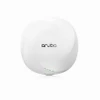Cost-Benefit Analysis of Upgrading to Wi-Fi 6E – HP Aruba Wi-Fi 6E Access Points

Wi-Fi 6E is a significant advancement in wireless technology. As businesses rely more on cloud services, video conferencing, and IoT devices, the need for faster and more efficient Wi-Fi grows. Traditional Wi-Fi networks can become crowded, slowing down performance and frustrating users. Wi-Fi 6E addresses this by introducing a new 6 GHz band, which offers more bandwidth and less interference.
Announced in 2018, Wi-Fi 6 (802.11AX) improved upon its predecessor, Wi-Fi 5 (802.11AC), by increasing speed, efficiency and capacity. Wi-Fi 6E takes these improvements further by adding up to seven superwide 160 MHz channels in the 6 GHz band.
This expansion provides multi-gigabit speeds and low latency, making it ideal for high-definition video, telemedicine, and distance learning. By reducing congestion and interference, Aruba Wi-Fi 6E supports the growing number of connected devices and helps businesses maintain productivity and innovation.
Differences between Wi-Fi 6 and Wi-Fi 6E
Wi-Fi 6 and Wi-Fi 6E are advanced wireless standards designed to improve internet connectivity. While both offer better speeds and efficiency compared to older Wi-Fi versions, they have some key differences. Wi-Fi 6 works on the 2.4 GHz and 5 GHz bands, while Wi-Fi 6E adds the new 6 GHz band, opening up more channels for faster and less congested connections. These differences make each version suitable for different needs and environments.

Speed and Range
Wi-Fi 6 provides fast internet speeds, operating on 2.4 GHz and 5 GHz bands. It supports speeds up to 1.146 Gbps. Wi-Fi 6E, on the other hand, extends into the 6 GHz band and offers even faster speeds, up to 1.788 Gbps. The 6 GHz band in Wi-Fi 6E allows for more channels with no overlap, reducing congestion and improving performance, especially in environments with many devices. Wi-Fi 6 can support older devices, while Wi-Fi 6E requires updated routers and devices to take full advantage of its speed and range improvements.
Router Compatibility
Wi-Fi 6 is backward compatible, meaning they can work with older Wi-Fi devices and routers. This makes it easier for many users to upgrade without replacing all existing equipment. In contrast, Wi-Fi 6E requires new 6E-enabled routers and devices to access the 6 GHz band. It is not backward compatible, which means older devices cannot use the 6 GHz band. This shift to 6 GHz aims to maximize efficiency with the latest technology.
Low Latency
Low latency is essential for real-time applications like video-conferencing and gaming. Wi-Fi 6E significantly reduces latency by using the unshared 6 GHz spectrum. With Intel® Wi-Fi 6E (Gig+) products, latency can be up to 75 percent lower compared to Wi-Fi 5. This results in faster, more responsive wireless internet connections that offer better user experience without lag.
Applications
Both Wi-Fi 6 and Wi-Fi 6E support advanced applications like high-definition video, online gaming, and IoT devices. Wi-Fi 6 is ideal for dense environments with many connected devices due to its efficiency features like OFDMA and MU-MIMO. Wi-Fi 6E’s expanded spectrum supports more high-bandwidth applications such as virtual reality and telemedicine, providing smoother and faster connectivity in environments with heavy data usage.
Device Support
Wi-Fi 6 supports devices using 2.4 GHz and 5 GHz bands, accommodating a range of older Wi-Fi standards. Wi-Fi 6E includes these bands and adds the 6 GHz band, providing seven additional 160 MHz channels. This results in faster internet speeds and lower latency for devices that support Wi-Fi 6E, like the latest smartphones and laptops. For those with older devices, Wi-Fi 6 remains a strong choice, offering broad compatibility and improved performance over earlier Wi-Fi versions.
Key features of Wi-Fi 6E
Wi-Fi 6E is an advanced version of Wi-Fi technology that operates on the new 6 GHz band. It offers faster speeds, less congestion, and better performance for modern internet needs. This upgrade is especially beneficial for homes and businesses with many connected devices. Let’s explore the key features that make Wi-Fi 6E unique and beneficial;

- Increased Capacity: Wi-Fi 6E operates in the 6 GHz band, which adds 14 extra 80 MHz channels and 7 extra 160 MHz channels. This means more room for data, allowing the network to handle more devices without slowing down.
- Enhanced Speed and Performance: Wi-Fi 6E can achieve higher data rates because of the wider channels available in the 6 GHz band. This makes it ideal for activities that require a lot of data, like streaming 4K/8K videos or virtual reality.
- Reduced Interference: The 6 GHz band is less crowded than the older 2.4 GHz and 5 GHz bands. This means Wi-Fi 6E experiences less interference, resulting in more stable and reliable connections, even in crowded places like apartment buildings or offices.
- Improved Device Capacity: Wi-Fi 6E uses technologies like MU-MIMO and OFDMA, which allow the router to communicate with multiple devices at the same time. This improves the network’s efficiency and can support more devices, which is great for smart homes and offices with many connected devices.
- Battery Life Optimization: Wi-Fi 6E includes a feature called Target Wake Time (TWT), which helps devices like smartphones and IoT gadgets save battery life by scheduling when they need to wake up and communicate with the network.
- Higher Throughput: With 1024-QAM modulation, Wi-Fi 6E can transmit more data in the same amount of spectrum. This increases the overall throughput, making it suitable for high-bandwidth applications.
Benefits of Upgrading to Wi-Fi 6E
Wi-Fi 6E is a major upgrade in wireless technology, building on the strengths of Wi-Fi 6 while introducing significant improvements. This new standard operates on the 6 GHz band, offering faster speeds, lower latency, and greater capacity. These advancements make Wi-Fi 6E ideal for modern needs, from busy households to large organizations.
- Speed and Capacity: Wi-Fi 6E delivers much faster internet speeds using the new 6 GHz band. This means that devices like smartphones, laptops, and IoT sensors can transmit data quickly without competing with older devices. High-resolution streaming, online gaming, and other bandwidth-heavy applications perform better with Wi-Fi 6E. The additional spectrum also supports more devices without congestion, making it perfect for crowded spaces like stadiums and offices.
- Lower Latency: Wi-Fi 6E reduces latency significantly, providing a smoother experience for real-time applications like video-conferencing and gaming. With the unshared 6 GHz spectrum, latency is up to 75 percent lower than with older Wi-Fi standards. This ensures fast and responsive connections, crucial for activities that require real-time interaction.
- Enhanced Security: Wi-Fi 6E includes advanced security features to protect user data. All Wi-Fi 6E devices must support Wi-Fi Protected Access 3 (WPA3), the latest security protocol, which offers better encryption and protection. This makes Wi-Fi 6E networks more secure than previous versions, ensuring safe and reliable connections for critical applications.
- Improved Performance in Large Spaces: Wi-Fi 6E’s higher capacity and additional channels help solve connectivity issues in large, busy areas. Whether in a school, hospital, or business setting, Wi-Fi 6E provides robust and reliable network performance. It supports high-density environments and ensures that all devices can connect without slowing down the network.
Cost Considerations of Upgrading to Wi-Fi 6E
Upgrading to Wi-Fi 6E comes with many benefits, but the cost can be significant. To decide if it’s worth the investment, IT leaders should weigh the expenses against the potential gains. First, they need to consider their current setup. Will existing devices be compatible, or will a complete overhaul be necessary? The cost of upgrading network architecture can vary widely based on these factors.
Balancing these costs with potential savings is crucial. Wi-Fi 6E can increase efficiency and productivity, helping to recover some of the massive annual productivity losses globally. Additionally, investing in Wi-Fi 6E now can prepare organizations for future technologies like Wi-Fi 7 and 8, potentially reducing the need for further costly upgrades down the line. By considering both immediate and long-term benefits, organizations can make a more informed decision about upgrading to Wi-Fi 6E.
HP Aruba Wi-Fi 6E Access Points role in driving innovation and future developments
As organizations rely more on bandwidth-heavy applications and a growing number of devices, traditional Wi-Fi networks struggle to keep up. This can lead to poor performance and frustration for users. HP Aruba Wi-Fi 6E Access Points offer a solution by providing cutting-edge technology that drives innovation and prepares networks for future developments. Let’s explore how HP Aruba Wi-Fi 6E Access Points enhance connectivity and support growing demands;

- Greater Capacity and Speed: HP Aruba Wi-Fi 6E Access Points use the 6 GHz band, which includes up to seven superwide 160 MHz channels. This nearly triples the available capacity, ensuring faster performance and minimal interference. The 650 Series APs, for instance, offer up to 7.8 Gbps data rates and use 4×4 MU-MIMO technology to support many devices simultaneously.
- Maximized Channel Utilization: Aruba’s patented ultra tri-band filtering optimizes channel use by dynamically adjusting channels to reduce interference. This ensures that the network operates smoothly even in dense environments, maintaining high performance and reliability.
- Enhanced Efficiency and Security: Wi-Fi 6E extends the 802.11ax standard into the 6 GHz band, enhancing efficiency and security. Technologies like OFDMA and Multi-User MIMO improve network efficiency, while security protocols like WPA3 and Enhanced Open protect data and ensure safe connections.
- IoT Integration: HP Aruba Wi-Fi 6E Access Points are ready for the Internet of Things (IoT). They come with integrated Bluetooth Low Energy (BLE) and Zigbee support, simplifying the deployment and management of IoT devices. This includes asset tracking, security solutions, and sensors, making the network more versatile and future-proof.
- Dynamic Traffic Steering: These wireless access points can automatically balance traffic across different bands (2.4 GHz, 5 GHz, and 6 GHz), ensuring optimal performance. This dynamic traffic steering helps manage network load efficiently, preventing any single band from becoming congested.
Conclusion
Wi-Fi 6E is a significant leap in wireless technology, expanding on the improvements of Wi-Fi 6 by adding the new 6 GHz band. This enhancement offers greater bandwidth, faster speeds, and reduced interference, making it ideal for today’s high-demand environments. By utilizing up to seven superwide 160 MHz channels, Wi-Fi 6E supports the increasing number of devices and applications that rely on robust, high-speed connectivity.
Upgrading to Wi-Fi 6E, especially with HP Aruba Wi-Fi 6E Access Points, presents clear benefits in terms of speed, capacity, and efficiency. The initial cost of upgrading can be offset by the long-term gains in productivity and network performance. HP Aruba Wi-Fi 6E Access Points play a pivotal role in driving innovation, enabling organizations to meet current demands and prepare for future technological advancements.
The Techjockey content team is a passionate group of writers and editors dedicated to helping businesses make informed software buying decisions. We have a deep understanding of the Indian software market and the challenges that businesses face when choosing the right software for their needs. We are committed... Read more




























